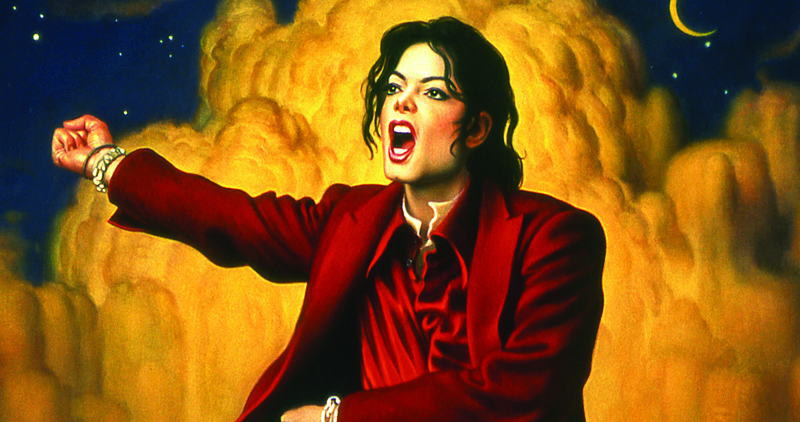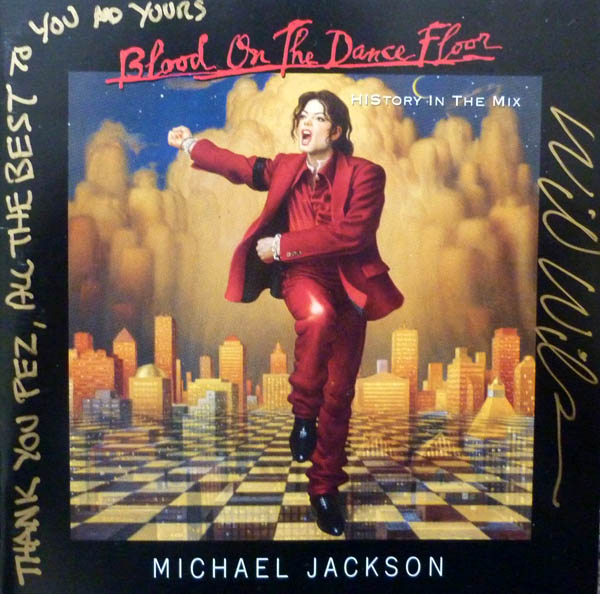This article is based on “Bringing Blood On The Dance Floor to Life” written by Pez Jax on pezjax.com and reproduced with kind permission of the author.

What’s interesting about Blood specifically is that it’s long been the subject of wild conspiracy theory and suggestion. Everything from Michael speaking out against Masonic and Illuminati forces, to being a ‘blood sacrifice’, to predicting 9/11, have been presented.
And yet, it’s all nonsense.
In 2012, I wanted to put these ludicrous theories to bed once and for all, so I reached out to the album cover artist Will Wilson to discuss the piece.
While in Perth Australia on the first leg of the HIStory World Tour, Michael sat down with European Sony Boss Paul Russell and Senior VP of Communications Jonathan Morrish to discuss his next venture targeted mostly to the European market:
“The tour embarked on the European leg then on to Australia” recalls Morrish. “I went down there to have a meeting with my boss Paul Russell and Michael about unreleased stuff which became Blood On The Dance Floor. It was discussions in Perth where Blood on the Dance Floor came to life.”
After leaving Australia, Morrish returned to the UK to begin work: “This is early December 1996 so I came back to England and we had Michael’s commitment to put stuff together for Blood on the Dance Floor which was then released when he came back in summer 1997.”
In the studio, a smaller team was compiled from the HIStory crew to work on the record, pulling songs from the HIStory and Dangerous album sessions to become worthy contenders. As engineer Rob Hoffman recalls: “Morphine was definitely something we worked on for HIStory, (Ghosts and Is It Scary) Both were worked on for HIStory. ‘Ghosts’ and ‘Blood On The Dance Floor’ were Teddy Riley tracks and were born before that, maybe the Dangerous era!”
Meanwhile, Art Director Nancy Donald kicked into gear to arrange the artwork for the album’s cover.
Famed photographer Albert Watson was selected to shoot the cover photo in Tokyo, Japan giving the album a more futuristic feel, as Watson reflects: “Well, in the very beginning, I was to photograph him in Tokyo for “Blood on the Dance Floor” and I went all the way to Tokyo but when I got there and we prepared everything in the studio, he was sick, he had a bad cold and he couldn’t do the shooting so I came back and they ended up with an Illustration. So I didn’t do the photograph for it and then later he called me on the phone and said he was sorry about Tokyo but he would like me to do the next cover and could I meet him in 2 weeks in the Four Seasons Hotel in New-York and I went to meet him and we had a drink together.“
Watson would go on to shoot the cover photo for Michael’s final studio album Invincible, but Blood was still without a cover and the team at Sony felt that with Michael’s hectic schedule, a piece of artistic expression may be more suitable.
Michael had seen a piece titled ‘Sleep Walking’ by artist Will Wilson and inquired about buying it. Unfortunately, it had already sold so Wilson produced a print and sent it to Michael. From this exchange, Michael chose Wilson as the cover artist for Blood on The Dance Floor and instructed Donald to brief him on what they were looking for. The timeframe to turn the cover around was just three weeks:
“Basically, they wanted a concept with him dancing on a semi-transparent dance floor with a generic city in the background. That was the only directions I received from them.” Recalls Wilson. “Then I did some primary drawings and had them approved by Michael and Nancy and once this was done, I started the painting.”
Inspiration for the Michael’s look came directly from the short film he was shooting for the lead single, the title track ‘Blood On The Dance Floor’, which was turned around relatively quickly as far as Jackson videos go. “We rehearsed for like 5 days and filmed for 2 or 3 days” recalls Sybil Azur who appeared as ‘Susie’ in the short, “and because we were doing Salsa and he didn’t know anything about Salsa and he was really opened to learning and very eager and excited! He seems very generous partner!”

On a break between sets, photographer Bill Nation captured a series of photographs of Michael in various poses for Wilson to then work from. I asked Wilson if this was his source material and he confirmed:
“It was just pictures of him dancing in the red leather suit from the photographs they gave me. I kind of made the background with the clouds, the mirror of the city.
This put to bed a claim by some that the legs on the album cover were taken from a photograph from the set of ‘Come Together’. Only the photos from the specified shoot were used.
Since the album’s release, there has been many fan theories circulated about hidden meanings within the city skyline, all of which Wilson confirmed not to be true: “They asked me what the clouds mean, and I said I didn’t know, I just tried to make it nice. There is no hidden meaning in the painting.”
The city was set against the night sky, a decision that added to the mood of the piece: “I don’t remember them asking for it to be night-time. It just ended up that way as it is more dramatic and gives a bit of more surreal of feeling.”
Asking Wilson about what appear to be broken chains around Michael’s wrists which were ultimately just thick bracelets, Wilson concludes “That was literally what he was wearing on the photographs. Nothing has been added.”
To date, only a handful of the images that were provided to Wilson have been released, most notably used for the Xscape and album project and again in 2017 when the Michael Jackson Estate released one online to coincide with their Halloween compilation, Scream.
On completing the artwork Wilson packaged the 15×15 inch painting into a box and handed to a Fedex driver. As the driver was preparing to leave “the phone rings” exclaims Wilson “it’s Michael Jackson on the phone asking for me to paint an arm band on his arm. I said I am so sorry, I just missed the driver and he asked if someone else could paint the arm band on the painting. I literally put the phone down and ran into my driveway. He was still on the phone and the truck was still there. I painted the arm band while the painting was still in the box.”
Wilson stated that he never figured out what the armband signified and when asking for its inclusion, Michael didn’t tell him of its significance. Though Michael often sported an armband in different colours, in western culture a black armband usually signifies a person in mourning.

Much like the Dangerous album cover, the obscurity of the Blood On The Dance Floor cover created conversation and intrigue; something Michael had long enjoyed the thrill of. Though something even he wasn’t aware of was one hidden secret in the album’s cover which Wilson revealed exclusively to me for the first time since 1997 – “I never told anybody about that” he divulged. “I have a cousin Matthew Hammond, he is the biggest Michael Jackson fan I’ve ever met. I told him that if I got the commission, I would put his initials somewhere and no one will be able to find.”
Needless to say, the initials MH are hidden within the album’s cover “it is in the left-hand corner. Some of the windows are light up in the building to create a M and a H next to each other. I’ve never told anybody until now.”

So the myths can finally be put to bed for once and for all.
SOURCE: Pez Jax




Merci pour cette mise au point au sujet de la couverture de l’ album !
Great informative piece about the cover of what is probably my favourite MJ album! Thank you, Pez and MJVibe.